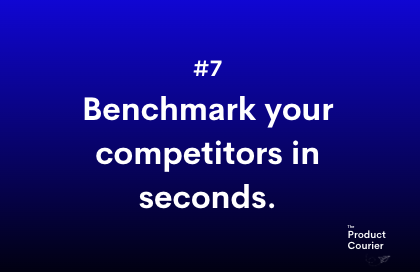Benchmark Your Competition in Seconds.
Stop wasting time manually filling out Notion tables and Google Sheets. Focus on high-quality competitive analysis instead.
✨What you're going to learn this week✨
✅ Save days on competition analysis using AI tools
✅ Scrape competitor content in 2 clicks with Thunderbit free plugin
✅ Automate benchmarking for multiple competitors simultaneously
✅ Synthesize data using ChatGPT/Claude-3 to create insightful deliverable
Get ready to accelerate your competition analysis. 🔥
"If you know the enemy and know yourself, you need not fear the result of a hundred battles. But don't get obsessed by insignificant details. Focus on making your own product irresistible, and you'll swipe right past the competition."
Might have been written by Sun Tzu
(If he had lived in 2024 and was a Product Manager).
Benchmarking the competition is an crucial aspect of a product professional's daily responsibilities.
However, let's be honest—it's an incredibly time-consuming process that often involves:
Analyzing countless product and documentation pages, one by one.
Manually copying and pasting content into tools like Google Sheets or Notion.
Cleaning the collected data to extract meaningful insights.
Transforming the synthesized content into presentable slides for internal sharing.
In essence, competitive benchmarking is one of the most unoptimized and inefficient tasks in a product role.
But here's the good news: it's now possible to accelerate these tasks by up to 10 times! 🏎️
Imagine having those countless hours back in your schedule. Perhaps you could:
Dive deeper into customer feedback and analytics.
Dedicate more energy to roadmap development.
Or simply achieve a healthier work-life balance.
Let’s give you these hours back! 🤩
Use case #1.
Get a summary of a product page in seconds.
Estimated time saved 🕒 : 1 hour per competitor.
In this tutorial, we'll be using the Thunderbit Chrome Plugin – a free tool that I've recently started using on a daily basis (this is not a sponsored post).
By utilizing this plugin, you can quickly gain an overview of a product and its features. Moreover, it serves as an exceptional tool for preliminarily analyzing a product's positioning and messaging.
To get started, follow these simple steps to set up your browser:
Visit https://thunderbit.com/
Install the Thunderbit Chrome plugin, which is completely free.
That's it! You're now ready to begin using the plugin.
Now, let's dive into the process!
Navigate to the product page you wish to analyze.
Click on the Thunderbit plugin icon at the top of the page.
Launch the summarizer feature.
And just like that, you'll have a comprehensive synthesis of the page at your fingertips! You just have to copy/paste it in Notion or Spreadsheet.
To illustrate, here's an example using Scaleway's Observability Product, Cockpit.
This process can be replicated across various types of pages, including pricing, blog posts, research articles, newsletters, and more.
Use Case #2.
Benchmark automatically your competitors in bulk.
🕒 Estimated time saved: from 4 hours to several days.
Let's take a closer look at how we can scale this process and analyze multiple competitors simultaneously.
To achieve this, we'll leverage the AI automation feature within the Thunderbit Chrome Plugin.
Set up a spreadsheet with your benchmarking criteria as column headers. Given the plugin's reliance on AI, it's crucial to be precise with the terminology you use.
Click on the Thunderbit plugin icon in your browser corner.
Select "AI Web Clipper" to initiate the automation process.
Choose your preferred output destination: Google Sheets, Airtable, or Notion. ⚠️ For security precaution, use a non-critical email address instead of your professional credentials.
Navigate to each competitor's page and click on your newly created automation to extract the relevant information.
As you progress through the competitor pages, the plugin will automatically populate your chosen output (Notion, Airtable, or Google Sheets) with the extracted data.
To illustrate this process, let's consider an example where we benchmark Managed Kubernetes solutions:
Using the following criteria: Company Name, Page URL, Product Category, Tagline, Secondary Tagline, Product Summary, Features Highlights.
Here’s the workflow in video.
Use Case #3.
Compare and synthesize your findings using Claude-3 or ChatGPT.
🕒 Estimated time saved: 2 hours.
Fantastic! You've now learned how to quickly synthesize a product page and automate your competitive benchmarking process.
However, let's face it – most people won't invest the time to read through the entire document.
That's why it's crucial to transform this information into digestible, shareable insights.
Here's how you can do it:
Review the table and carefully examine each competitor analysis.
Remove any information that's not essential for the overall analysis.
Copy and paste the following prompt into your preferred AI tool (such as ChatGPT or Claude-3) and include your table in CSV format.
Prompt: As a Product Marketing Manager at a (industry. Ex: cloud) company, you have compiled a spreadsheet comparing the (product category or type. Ex: Managed Kubernetes Solutions) of your main competitors (see attached CSV file). Your task is to synthesize the key findings from this benchmark analysis.
Instructions:
Analyze the competitors' product positioning and messaging. Identify common themes, unique selling points, and target audiences.
Create a comparative table highlighting the key features each competitor emphasizes. Use checkmarks or other visual indicators to show which features are offered by each competitor.
Discuss the pricing strategies employed by the competitors. Note any similarities, differences, or lack of pricing information.
Focus on insights that can be derived with certainty from the provided data. If there are areas where you lack sufficient information to draw conclusions, mention them separately.
Present your findings in a clear, concise manner, avoiding unnecessary details or repetition.
Deliverables:
A written synthesis of the competition benchmark, covering product positioning, feature comparison, and pricing strategies.
Feel free to customize the instructions to suit your specific requirements.
By the way we’ve built a full prompt library for PMs and PMMs. Check it out!
Best Practices: Double check the insights provided manually.
The ability to scrape competitor content doesn't replace the need for thorough benchmarking. Instead, use AI to accelerate your research process and focus your time on high-value tasks.
Here are a few best practices to keep in mind: 🧠
Before scraping and analyzing content, take a moment to familiarize yourself with your competitors' pages.
Only after reviewing the pages, proceed with using AI to scrape the content. This approach allows you to assess the quality of the AI-generated output more effectively.
Once you receive the final synthesis, take the time to double-check the AI's conclusions.
By following these steps and best practices, you'll be able to transform your competitive benchmarking data into actionable, shareable insights that drive informed decision-making and strategy.
✨ And save days in your Product Career! ✨
Wait a minute! We have a word for you.
Our content is completely FREE.
We spend countless hours crafting high-quality tutorials that not only work but also make your job easier.
What you may not realize is just how much your feedback motivates us. ❤️
➡️ If you enjoy our content, your positive feedback will inspire us to keep going.
➡️ If there's room for improvement, your feedback will guide us in the right direction.
Fill out this very short form to support us!
You can also show your support by:
Smashing that like button at the top (or bottom) of the page.
Sharing this tutorial with your team or your network.
Follow-us on Linkedin: Lucas Nilsson and Toni Dos Santos
Thank you for your support ❤️








Super nice content, I find it very useful as a PMM!
Lucas and Toni, this helps a lot to at least bootstrap your competitor analysis.